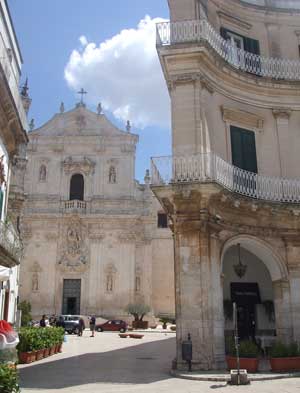About Martina Franca
Martina Franca is a fair-sized town (population: 49,000) in the heart of Puglia, southern Italy. It has some ugly modern areas, but the town’s jewel is its lovely historic centre, a memorable maze of winding alleys, where whitewashed simplicity sits side by side with baroque extravagance. The town is built on a hill in the green Valle d’Itria, the trulli area of Puglia, and it makes a good day trip if you are exploring the region or a pleasant stop-over on a tour. Martina Franca is an incredibly photogenic town, so come equipped to take lots of pictures: the narrow lanes that are so hard to photograph well in other Italian cities are here illuminated by whitewashed walls, pale stone and tiny open spaces.
Things to see in Martina Franca
The main entrance to the old town centre (centro storico) is through a grand historic gateway, Porto Santo Stefano (also called the Arco di Sant’ Antonio), in Piazza XX Settembre. In the piazza and park outside the town walls, old men gather and natter. Just inside the gateway is the pretty little Piazza Roma, one side of which is dominated by the Palazzo Ducale, Martina Franca’s grandest civic building. Built in 1668, this was once the palace of the Caracciolo family, the dukes who presided over the town’s glory days. Nowadays it houses the town hall, a library and Martina Franca’s tourist information office.
A map from the tourist information office outlines a short walking tour of the centro storico, but really you might just as well glance at the map and then wander. We found the lady in the temporarily-relocated tourist information office to be very helpful and well-equipped with leaflets, bus timetables and information. Among the advertising leaflets were organised excursions to masserie (agricultural estates) in the nearby countryside – a nice idea if you are staying locally.
The patron saint of Martina Franca is San Martino (St. Martin), generally represented on horseback sharing his cloak with a beggar. You’ll notice the image a few times around town, including a large bas-relief on the facade of the Basilica di San Martino, Martina Franca’s principal church. The basilica sits right in the heart of the centro storico in Piazza Plebiscito. The grand baroque building dates to the eighteenth century, though it was only awarded ‘basilica’ status in 1998. The facade is heavily ornamented and the interior, too, is ornate: look out for dangling cherubs and fake marble altars. Tourists should also visit and marvel at another church nearby: the Chiesa di San Domenico, also eighteenth-century and extravagantly-decorated.
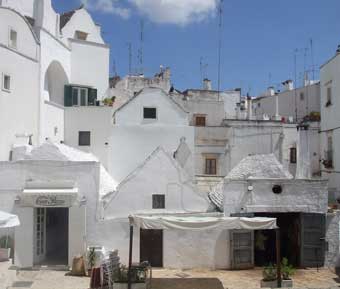
The centre of Martina Franca is charming, and worth roaming around for an hour or two, with cameras at the ready. The oldest part of town is called the Lama, where you can still see the pointed-roof buildings which are a local tradition. Wandering the lanes and alleys you pass eighteenth-century palaces, some of which are shabby with age, as well as humbler dwellings. All are tall and squeezed together in this small area within the old town walls. Ornate balconies and archways decorate the more elegant buildings, along with fancy baroque windows, and those ubiquitous cherubs. The centre has a lived-in feel, with laundry and sometimes foodstuffs hung outside to dry. Although it is mostly pedestrianised, little three-wheeled ape trucks occasionally appear, plunging alarmingly down the narrow lanes; sheets of metal are screwed onto walls to protect buildings from the knocks of vehicles squeezing past.
Guidebooks and the town plan direct you to a belvedere just outside the centre on Via Pergolesi praised for its views over the trullo-speckled Valle d’Itria. However when we visited the trees had grown up so much they obscured the view, and all that was left was a dusty shady park populated by snogging teenagers. Glimpses of view could be appreciated from a steep lane alongside, but unless the trees are pruned or you’re visiting in leafless winter, don’t expect an extensive panorama. A rather more curious and picturesque viewpoint is further along on Via Bellini, where there is some open land below the road described as orti medioevali, medieval fields.
Martina Franca is the base for the annual Festival della Valle d’Itria, a summer opera festival. Operas and classical music concerts are performed in venues around town including the Palazzo Ducale and the Basilica di San Martino. The event takes place around the end of July and beginning of August.
Martina Franca food and drink
For everyday food, drink and take-aways, a travellers’s best bet are the busier streets just outside the historic centre. Within the picturesque part of town though, there are some nice restaurants including a couple under the arches in Piazza Immacolata. We ate at the first of these and were impressed by the special vegetarian listing within their mixed menu, the good fresh pasta dishes and the welcoming free glass of wine and titbits.
Martina Franca travel
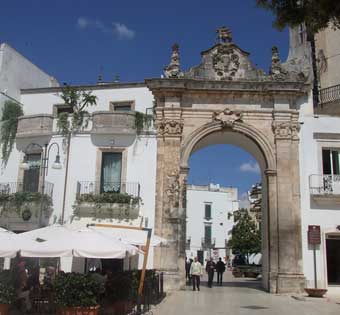
The best airports for Martina Franca are Bari and Brindisi, both served by budget airlines from the United Kingdom. Martina Franca is a hub on the little Ferrovie Sud Est (FSE) railway line, with direct (if slow) train services to Alberobello, Bari, Taranto and Lecce. Brindisi can be reached by taking FSE train services to Francavilla Fontana and then changing to a bus.
The railway station in Martina Franca is downhill from the town centre, and on arrival visitors need to walk for 10-20 minutes to reach the pretty part of the town. There is a quick direct route, but it is hard to navigate on arrival (it’s easier on the return walk, once you’re equipped with a town map). A simpler way is to leave the station and follow Viale della Stazione which curves up to the right. Then walk left along Via Alessandro Fighera until you come to a junction with Corso Italia. Turn left and follow this long straight street until you reach Piazza XX Settembre, the main entry point to the centro storico.
Around Martina Franca
Alberobello is the main tourist destination in the trullo-dotted Valle d’Itria, and it is a very short train journey from Martina Franca on the little FSE trains. Between the two towns is the pretty hilltop destination Locorotondo, another picturesque stop on the railway line. Ostuni is one of the most well-known of the ‘white’ hilltop towns in Puglia, though it is tricky to reach if you don’t have a car. There are buses from Martina Franca to Ostuni, but they run at rather inconvenient times – check at the tourist information office for the latest timetables. Cisternino, another ‘white town,’ is just one stop away on the FSE railway line. The town’s handy rail connections with Bari, Alberobello and Lecce mean it is easily incorporated into a varied tour of the Puglia region.
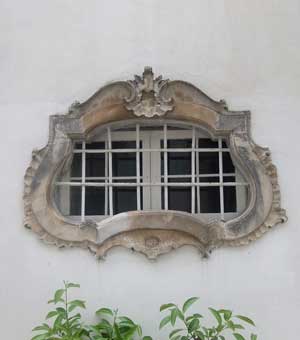
Martina Franca accommodation
As well as accommodation in Martina Franca there are quite a few good accommodation options in the countryside around town, including old agricultural estate buildings called masserie. For an unusual choice in the town itself, you could try Villaggio In, a kind of albergo diffuso (‘scattered hotel’) where lodgings are in various small apartments dotted around the town centre.
> Martina Franca accommodation
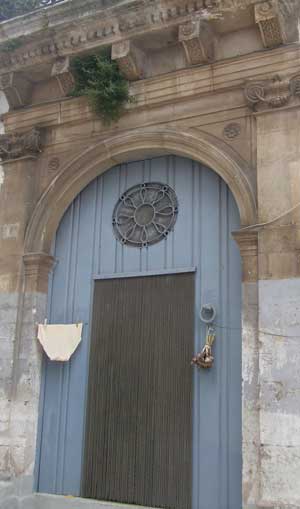
Useful external links
